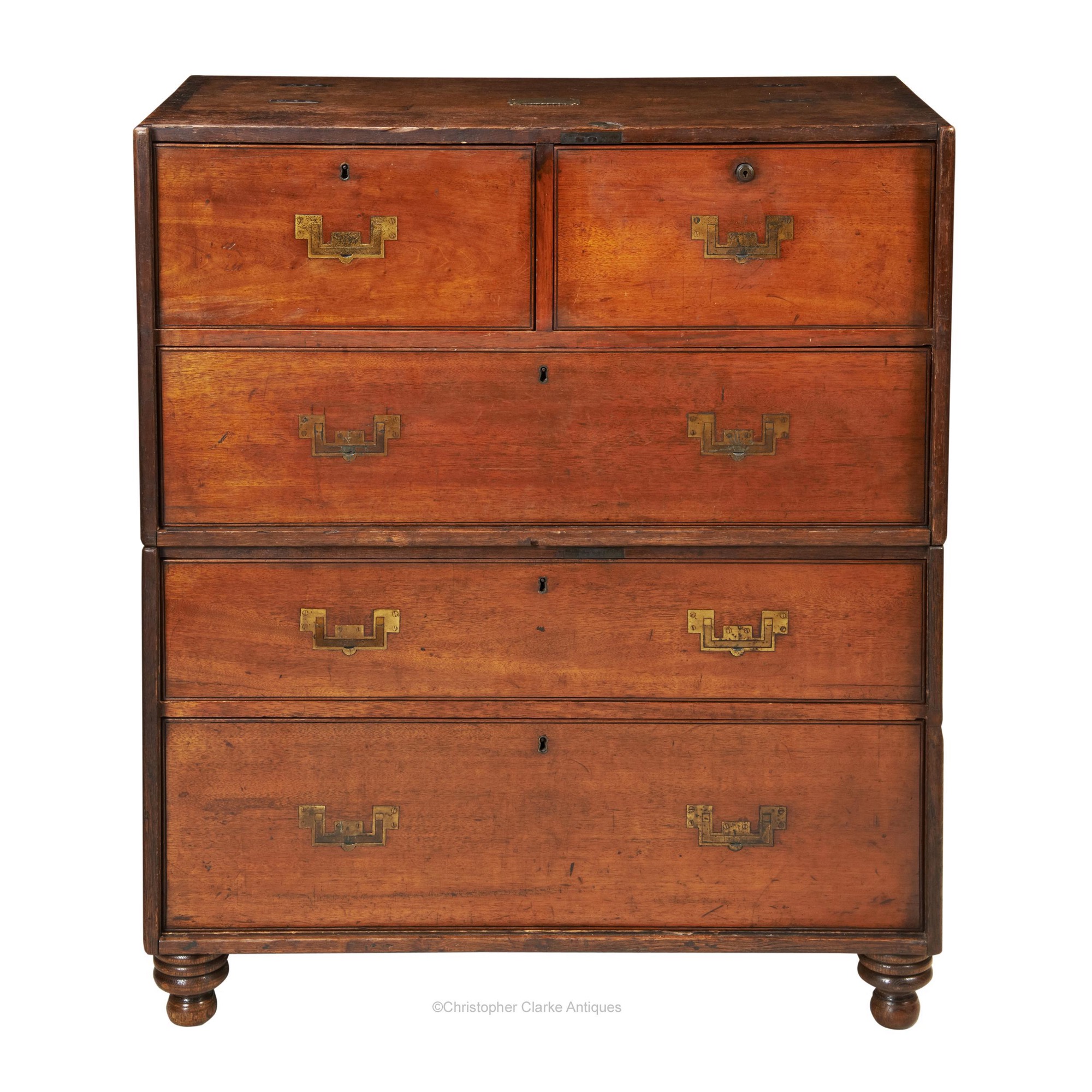Huband's Packing Case Chest
Huband's Packing Case Chest
82661
George Huband of the 8th Hussars', oak Packing Case Chest.
Although 25 years earlier in date, this chest is comparable to that of Lieutenant Donovan illustrated in our England Expects catalogue. The oak carcase is made as packing cases with a pair of flush campaign handles to each side of the two sections. They are standard drawer size handles as opposed to larger for carrying but perhaps that is why two were used. Smarter mahogany show wood has been used to the drawer fronts with good, gilt lacquer brass skeletal handles. The top right-hand drawer has a replaced J. Bramah Patent lock with round eschutcheon. The drawers are set back from the front of the chest to allow a facia board. Each board (now lost) slides down from the top to protect the drawer front and complete the packing case. They are held by grooves to the extended sides and bottom of the chest with a lock to the top securing each board in place. This is an unusual method and the lock escutcheons have a simple brass cover.
The system for uniting the two halves, when set up for use, is clever and the same as Donovan's chest. To the middle of each side of the bottom section is an inset brass fitting with a lift up flat, square lug. These fit to corresponding brass fittings to the top section, fixing the two parts. The chest has replaced turned feet which are removable on steel threads. To the top of the chest are four inset brass plates and it is likely that these were originally to fix a superstructure shelf, long since gone. The back of the chest is panelled and has a label for Spread Eagle Universal Coach, Van and Steam Packet Office in Piccadilly.
To the top of each section is an engraved brass plate noting 'Geo. J Huband Esq.r, 8th Hussars'. George was born in 1809, the son of Wilcocks Huband, a Dublin barrister and amateur etcher. Known by his middle name Joseph as a child, Huband followed his father's artistic interest winning aged 13, a silver medal from the Dublin Society in 1822 for a small comic book of etchings. He discontinued his interest in art believing it would distract him from more important studies although late in life he would serve on the Society's Fine Arts Committee. On the 9th August 1831 he enlisted in the 4th Queen's Own Light Dragoons purchasing the rank of Cornet. In October 1834 he was promoted to Lieutenant and in February 1837 exchanged with John Miller from the 4th to the 8th Kings Royal Irish Light Dragoons (Hussars). He became a Captain by purchase on the 8th of February 1842.
The 8th Hussars spent quite a bit of time in Ireland and it must of suited Huband to be stationed closer to his home. He was noted in the social sections of the Irish newspapers as attending a number of society events and joined the Royal Horticultural Society of Ireland in 1840. On the 6th of October 1843 he went on to half pay with his army income dropping from 14s 7d a day to 7s 6d. On the 11th of May, Huband married Rear Admiral Croft's youngest daughter Marianne at Stillington, near York.
Huband is last noted in the Army List of 1845 as unattached and on half pay and it is likely he left the army the following year. The family settled in Ireland and lived at 7 Herbert Street Dublin. The family grew with sons, William born in 1845 and Hugo in 1862. By 1850, George had become a Poor Law Inspector in Cork. It was probable that around this date he was painted by James Butler Brenan, a Cork artist who made a career out of painting the great and the good of the city. He was a senior Freemason and rose to become Acting Great Prior Of Ireland in 1878 which was a great achievement for his station. George Huband died on the 13th of October 1878 at 39 Upper Mount Street, Dublin.
Although it is possible that Huband replaced the name plates to the chest, noting his new regiment, we have to assume that he purchased it whilst with the 8th Hussars. This would date it to between 1837 and 1843 when he went on half pay before leaving the army. This is an interesting chest for its packing case construction and it belonged to an interesting man who seems to have done well in Irish society. Circa 1840.
Dimensions:
Circa 1840
Mahogany & Oak
England
Huband Engraved Plate
Military Chest
George Huband, 8th Hussars
Facia Boards Missing. Removable Feet Replaced.
RELATED ITEMS


































